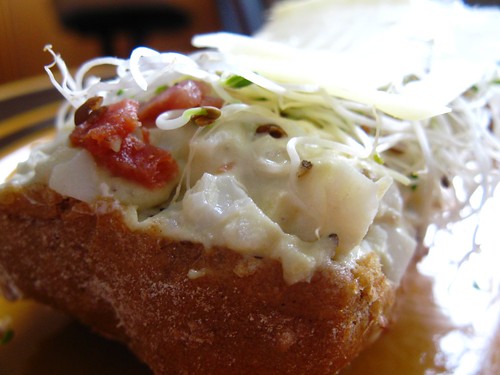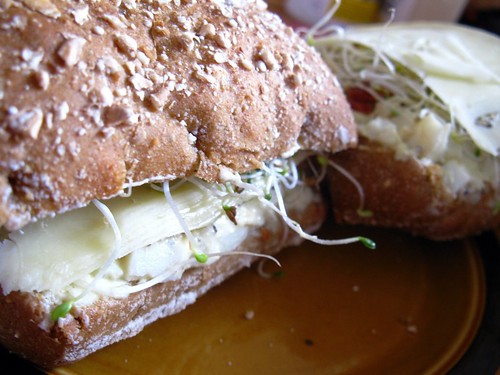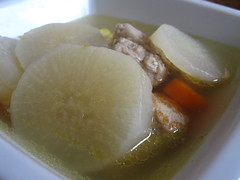Made char siew for Johan's favourite wanton mee and made some extra because I wanted to try making char siew bao for breakfast. Its one of my favourite breakfast item in Singapore, I normally go on weekend with my Dad at the Redhill market and had two with my morning cup of Teh-O.
Was searching the web for some good recipes, there's plenty out there but since this is my first attempt, I wanted something more reliable. Managed to find a
video demonstration of it and also the recipe from
here.
Here's the char siew recipe first:
Ingredients
500g pork fillet (I think its from the hind loin of the pig, over here they sell it in a long package of one whole long piece)
3 tablespoons of oyster sauce
13-fragrance seasoning powder (Got this from a Chinese friend, its a mixture of five spice powder, pepper, ginger etc. If you can't find it, use five-spice powder, pepper, onion, ginger and garlic powder)
A few drops of red colouring
Glaze (
from Lily's blog)
1 tablespoon honey
1 tablespoon dark soy sauce
1 tablespoon oil
Steps
- Cut up the pork fillet into long strips. I baked this by threading a wooden stick through one end of the fillet and hang it through the oven wire rack. So measure the distance between the highest level and lowest level of the oven racks to determine how long your pork fillets will be. Marinate them overnight in the fridge.
- Preheat the oven to 220 degrees celsius, thread the pork fillet through the oven wire rack and put it on the highest oven rack level. Prepare the dripping tray placed at the lowest level of the oven lined with aluminium foil and pour in some hot water. Bake it for about 10 minutes and turn down the temperature to 200 degrees and bake it for another 20-30 minutes.
- Five minutes before it is done, brush the glaze along the pork fillet, this will make it nice and sticky (yums :). You can make a big batch and store it in the freezer for whenever you need it.
Next, the char siew pau recipe, which I pretty much followed to the letter. At first I was worried that I have to go with plain flour instead but to my pleasant surprise, I did get the right flours when I was shopping in Singapore the last time round.
Char Siew Pau (as extracted, I add in some comments from my first time attempts)
Ingredients for dough (makes 16 buns):

Bun
8g instant dry yeast (
I used 25g of fresh yeast instead since it was a cheaper alternative here)
160ml lukewarm water
½ tsp white vinegar or lemon juice (optional) (
I used lemon juice)
280g low-protein flour aka hong kong flour
100g wheat starch (
or dim sum flour, the kind they use to make har kow)
90g icing sugar
30g shortening or vegetable oil
10g baking powder (
it was kinda of fun to mix this with the cold water, it sizzles!..Ok...normally I just add it in the flour so I don't get to see the 'real action' :P )
10ml cold water
Filling
A
250g char siew, diced
½ tbsp cooking oil
1 tsp sugar*
1 small onion, diced
1 tbsp oyster sauce*
1 tbsp soy sauce*
1 tsp. sesame oil
1-2 drops red food colouring (optional)
B
150 ml water
1½ tbsp corn flour
Salt to taste
*Some store-bought char siew comes with sauce, use it for preparing filling. Omit sugar, oyster sauce and soy sauce. (
Also, try to make the filling not too wet. It should be mostly dry, with just the sauce coating it. I think I made mine a bit too wet so had a hard time wrapping the pau)
Method:
Fillings
1. Heat oil in pan, sauté onion for 1 to 2 minutes. Add in all other ingredients A, stir fry for 1 minutes.
2. Mix together water with corn flour, add mixture into the pan and stir well. Simmer until gravy is thickened.
3. Transfer to plate and allow to cool.
4. Divide filling into 16 portions if desired, set aside for later use.
Buns
1. Sift together flours and icing sugar. Place sifted flour mixture in a large mixing bowl and make a well in the middle.
2. Fill well with lukewarm water, vinegar and yeast. Use a spatula, gently stir the water to dissolve the yeast then slowly bring together flour mixture. (
since I used fresh yeast, I just crumbled and dissolve the yeast in finger warm water first, add it to the flour mixture, then add in the lemon juice)
3. Add in shortening or oil and knead for 10-15 minutes until soft dough is formed. It should be smooth on the surface.
4. Cover dough with damp cloth and let it rise for 30 minutes or until it is doubled in size. I used bread maker’s dough mode to prepare my dough up to this step. (
I didn't have any breadmaker so I did all manually)
5. Dissolve baking powder in cold water, sprinkle over dough and knead until well combined. Divide dough into 16 equal portions and flatten with a rolling pin to make a 3” circle. Then place a heap teaspoon of filling in the middle, wrap and pleat the dough to seal. Place it on a 1.5” square parchment paper, seal side up.


6. Arrange buns into a steamer, leave about 1” gab in between buns. Spray water mist over buns, and steam in a preheated steamer on high heat for 12 minutes. Remove buns from steamer and cool on rack to prevent soggy bottom. (
I didn't have a proper steamer, so I used my pasta pot, put in a microwave metal stand which provided enough distance from the bottom of the pot and the cover of the pot.)
These are the prettier looking ones
Notes:
1. If bigger bun is desired, divide dough into 12 equal portions in step 5.
2. There is no need to rest the dough after adding in baking powder, but if time allowed, rest it for 10 minutes or so to get fluffier buns.
3. Adding a few drops of vinegar into steaming water will produce whiter buns, but this is optional.
4. Steamer must be preheated otherwise bun would not rise to the volume as it should be.
5. Spray the surface of bun with water mist helps to produce buns with smooth surface after steamed.
6. DO NOT open the lid during the steaming process.
7. If there are yellowish spots on the steamed buns, it means the baking powder is not fully dissolved.



















































